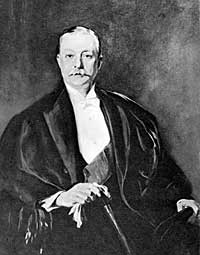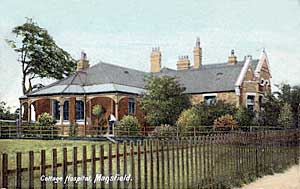Regarding the general district rates, in 1892, when the assessable value of the town was £33,754, the amount in the pound collected was 4/-, but in 1900, when the value had increased to £51,360, it had dropped to 3/3 the lowest figure it ever touched since the incorporation of the borough. The calls for the last few years have been as follows:—
Year ended |
Amount in £ |
Assets Value. |
31st March, 1910 |
3/8 |
£90,200 |
-1911 |
3/8 |
£95,600 |
1912 |
3/9 |
£106,383 |
1913 |
3/6 |
£112,035 |
1914 |
3/8 |
£115,174 |
1915 |
3/10 |
£121,470 |
1916 |
3/10 |
£123,837 |
1917 |
3/10 |
£127,703 |
1918 |
3/10 |
£128,752 |
1919 |
4/8 |
£128,747 |
The town is regarded as a healthy one. During the past twenty-five years the average death rate figures have fluctuated from 20.6 per thousand to 11.2 per thousand in 1917. Mansfield Corporation 3% stock, issued under a Consent Order of the Local Government Board, dated 5th October, 1895, is as follows:—
|
|
|
|
1895 |
£60,196 |
7 |
0 |
Average price, £101 12 3 |
|
|
|
Amount of Stock issued in exchange for Gas |
|
|
|
Debentures |
£36,464 |
8 |
0 |
Total stock |
£96,660 |
15 |
0 |
Amount of Stock cancelled |
40,592 |
13 |
9 |
|
£56,404 |
17. |
7 |
Gas Debenture Stock returns show that in December, 1895, the amount was £60,000, but the cancelling and conversion of stock at various times has reduced this amount to £14,050. Special Acts of Parliament have been obtained as follows:—
Mansfield Commissioners' Gas Act, 1878.
Mansfield Corporation Act, 1901.
(Royal Assent 26th July, 1901.) Mansfield Corporation Act, 1905.
(Royal Assent 11th July, 1905). Electric Lighting Order, 20th June, 1899.
" " " 2nd August, 1907.
In regard to the government of the town, it is interesting to note that in 1823 an Act of Parliament was obtained, intituled An Act for Improving, Paving, Lighting, Cleansing and Watching the Town at Mansfield." Forty-three commissioners were appointed to carry this Act into execution, and if they had done nothing else but purchase property in the centre of the town, which they pulled down for the purpose of making the present market place, they would have earned the thanks of their fellow-men. Another Act was passed in 1874, embodying the principal clauses of the Public Health Act, and reducing the number of Commissioners to 18. Later there was a strong desire expressed that the town should be incorporated, and steps were taken to get a charter, the late Mr. G. H. Hibbert and the present Town Clerk (Mr. J. H. White) being prominent townsmen to move in the matter. On the 13th of July, 1891, the Incorporation Committee proceeded to London, and on the following day returned with the charter. Many improvements have been carried out since that time, and the population has increased from 15,925 to about 45,000.
It is impossible in this short notice to give details, or even a passing glance, at the work of the Town Council, with its following committees:—General Purposes, Licensing, Gas, Water, Electricity, Highways, Health, Baths, Fire Brigade, Town Hall, Pleasure Grounds and Allotments, Charities, Finance, Free Library, Education, Pensions, &c., but suffice it to say, that the members are alive to the need for a progressive policy to meet the new demands that a growing borough will make upon them. Many new schemes, demanding large expenditures, to improve the town and the conditions under which the inhabitants reside are under consideration.
Amongst the properties belonging to the Corporation are the public baths, close to the Cattle Market. The site was leased by the Duke of Portland to the Baths Commissioners for 99 years from the 25th March, 1853, at a rent of 10/- per annum, and the buildings were erected by the Commissioners at an expenditure of £1,300. In 1886 the baths were assigned to the Improvement Commissioners, and the reversion was purchased in 1902 for £649 10s. In the following year extensions were carried out at a cost of about £7,300, and but for the war more much-needed accommodation would have been provided.
In 1885 the Corporation purchased the Town Hall and premises situated in the Market Place, including the Butter Market, offices and shops for £9,400, and with alterations the cost was brought up to £10,000. The Cattle Market stands on 13,600 square yards, and comprises settling rooms, caretaker's house and sheds. In 1876 the site was purchased for £1,700, the tolls for £1,000, and the buildings cost a further £3,500, and alterations have been carried out costing £2,800. The Forest Infectious Hospital is situated on the Southwell Road, and the Small Pox Hospital, on Brick Kiln Lane.
On the 10th of May, 1912, the Duke of Portland opened the new Sewage Disposal Works, situated between Bath Lane and Sheepwash Lane. They comprise over 28 acres of land, which was purchased from the Lord of the Manor for £5,500. The contract for the carrying out of the work was £26,728. There are Sewage Disposal Works also at Pleasley Hill.

The Duke of Portland.
Almost as we go to press it is announced that the Duke of Portland has offered to sell to the town the beautiful residence in Bath Lane known as Carr Bank, with 13½ acres of land, to be utilised by the town, and to be the borough's memorial to the gallant men who have fallen in the Great War. The price paid is not half its value, and this is another of the many kindnesses his Grace has shown to the borough. Although nothing of a very definite nature had been settled as to the details of the scheme, it is agreed that the house shall be used as a museum, and the contents of the present home of the Baily collection removed thereto. It will be a beautiful place for that purpose. There is some talk of the School of Art being moved to Carr Bank, but that had not got beyond the stage of suggestion when these notes were printed. The grounds will make a delightful park for Mansfield's residents. Its situation is picturesque. Other pleasure grounds are the Titchfield Park, which to-day contains reminders of the war in the shape of German guns and a "tank" will very shortly keep them Company; Westfield Lane ground, which is larger than the one situated on Nottingham Road; Sandy Lane, and the Pleasure Ground at Pleasley Hill, where an open-air swimming bath has been constructed; the Racecourse, which was conveyed to the Corporation by the Duke of Portland in 1910, and two acres of land near Thompson's Grove.

Cottage Hospital, Mansfield.
Mansfield also has a very fine hospital, built some 28 years ago; but since that time it has been added to, and to-day it is well equipped and commodious. Many wounded soldiers were treated there during the period of the war.
THE CHAMBER OF COMMERCE.
Although a comparatively young institution, the Mansfield and District Chamber of Commerce is making its presence felt, and as a progressive body stands well to the fore. The first general meeting was held in December, 1917, when the Duke of Portland, K.G., was elected the president, with Sir Charles Seely, Bart., who at that time was the Parliamentary representative for the division, vice-president. Mr. W. Holmes Reddan accepted the chairmanship of the Council, and a very energetic president he has proved to be. The Chamber is affiliated to the Nottingham Chamber of Commerce, Mr. Reddan being the local representative on that body. Sectional committees have been formed, and one of their members represents the Chamber on the Trade panel. The assistant secretary, in a report presented to the Chamber in May, 1918, made reference to the assistance rendered by the Chamber in connection with War Savings Boom Week, which was a huge success, more money being invested than the National War Savings Committee asked of the borough. As showing how thoroughly the Council went to work, it may be mentioned that they arranged for speakers to address public meetings, for cinematograph shows, parades of soldiers, cadets, scouts, children, etc. At this time the Chamber had a membership of 120—24 manufacturers, 78 traders, and 18 professional and other business gentlemen. In January, 1919, at a general meeting, Mr. Reddan said the spade work in connection with the formation of the Chamber had been got through during the past twelve months. It had, he said, been an extraordinary year on account of the conditions existing during the war and those now prevailing during the armistice period. He believed the Chamber was thoroughly well organised and thoroughly alive and equipped for doing everything that was necessary. At the same time, he thought the traders' section should meet more frequently, and that an engineering section should be formed, and the builders might also move in a like direction. The Chamber, with the object of increasing its influence, had become affiliated to the Association of British Chambers of Commerce, and through them hoped to get direct recognition by the Board of Trade. Continuing the report of the work of the Chamber for the year, the assistant secretary (Mr. W. Coxon) mentioned that the Chamber was of great assistance to the butchers in' the district by getting their frozen meat brought from Nottingham by rail in refrigerator vans during the hot weather. Resolutions had been passed by the Council restricting future trading with enemy countries, and the attention of the Town Council had been drawn to the inefficient state of the Fire Brigade. Apart from its ordinary duties, the Council helped to make the Machine Gun Corps Prisoners of War Fund a huge success, and it also raised a fund to purchase a wedding present for the president's daughter, Lady Victoria Cavendish Bentinck. At Thanksgiving Week the Council, as the executive committee of the local War Savings' Association, did much to help the town to score a great triumph in raising money for War Loan. A series of lectures had been arranged, and as an indication of the work done during the Chamber's first year of existence it might be mentioned that the assistant secretary had written over 200 letters and sent out more than 1,600 circular letters and notices. At the end of the year the treasurer (Mr. A. Worman) was able to announce a credit balance of £119 10s. When the last returns were published the membership was 150.
INDUSTRIES.
The main industry is coal. With the exception, probably, of the Doncaster Coalfield, that of Mansfield is the most extensive in the country. Therefore Mansfield and neighbourhood is favourably placed for the establishment of new industries. Let us glance at the possibilities of the borough in that connection. The big coal boom has come since 1900, so that the pits in the immediate neighbourhood may be said to be comparatively new ones. Down the Leen Valley the collieries at Newstead, Annesley, Kirby, and Hucknall, to name but four, have been working many years, and there was a considerable exodus from these valley pits to the rapidly-developing district around Mansfield a decade or more ago. There is no colliery within the borough boundary, although the coal under the town is being worked, but there are three close enough to be called Mansfield pits. Two are in the parish of Mansfield Woodhouse, and one is just over the boundary stream which separates Notts and Derbyshire at Pleasley. In pre-war days the new pits were producing enormous quantities of coal. One of them is said to have established a world's record, inasmuch as on the 17th of May, 1912, in seven hours and forty minutes, 4,915 tons 15 cwts. of coal was brought to the surface, and in the same month, in 5½ shifts, the amount brought up the shaft was 25,647 tons 2 cwts, which is claimed to be the biggest aggregate ever wound in the same time. Another of the pits, which prior to the war breaking out had only just commenced to win coal, is now fully going, and a model village is springing up on the hill-side near by. The lay-out at this colliery is to deal with 4,000 tons a day. In addition to these new pits, there are those at Pleasley, Shirebrook, Songwith, and the Sutton and Kirkby group, all within a stone's throw, as the saying goes, of the market town. But let us look for a moment at the possibilities for the district in the near future. To the east of the town extensive preparations are being made to tap the coal. Sinking operations are contemplated at Blidworth. A site has been purchased on Belle Vue Farm for putting up colliery works, and the arrangements at the time of writing were so far forward that before very long the work of construction will be in progress there. In the vicinity, too, of the great military camp at Clipstone a new colliery headstock and buildings are erected, and probably on a portion of the camp ground a new garden city will spring into being. Plant is being installed to raise 4,000 tons of coal per day at this pit. A little further away at Bilsthorpe, negotiations have been completed for the sinking of a pit, and boring operations are being carried out near Ollerton, the pretty little village on the very edge of Sherwood Forest. If these operations prove successful a pit will be sunk there. The prospects in the Farnsfield area have been very discouraging. Three bore holes have been worked, but none have proved satisfactory, and at Kirklington the boring has been no more lucrative, and attempts to sink a pit there have been abandoned. Another coalfield in the market is in the Maplebeck district, but that will of course depend upon the boring results as to whether it will pay to work it. The new pit near the Clipstone camp will, it is hoped, be producing coal in 1921. In some districts a little wider afield preparations are being made to tap the lower measures. In the Glapwell district the lower seams have been tested, and so satisfactory have they proved that it has been decided to sink to them, and there is little doubt that in the Pleasley, Cresswell, and Langwith districts deeper sinking will soon be resorted to. The deep hard coal is about 170 yards below the top hard; the deep soft is from 20 to 25 yards lower, and the black shale some 300 to 350 yards from the top hard. But that is not deeper than some of the workings in the Doncaster area. As showing the difficulties that the pit sinker has to encounter in his hazardous occupation, we might mention that at the colliery between Market Warsop and Budby a good deal of water was tapped. At the No. 1 pit 50,000 gallons per hour were pumped, whilst at the No. 2 shaft the largest quantity was 20,700 gallons per hour. Here the top hard coal is 5ft. 9in. thick with a clunch parting, varying from 8in. to 11in. between it and the "coombe" coal, which is 15in. thick. The High Hazel seam was found 3ft. 10in. thick at a depth of 612 yards. A well-known authority, questioned on the life of the coal of this district, places it at 200 years. It will be seen from these particulars that Mansfield occupies a unique position in regard to coal, and the borough is comparatively near to Lincolnshire iron-fields, and therefore eminently suitable for works designed to deal with these mineral productions. There is an abundance of good moulding sand, and so far as railway facilities are concerned it is favourably placed. At the time this brief history was written there was a Bill before Parliament for powers to construct railways to carry the Blidworth and Bilsthorpe coal when it is available.
